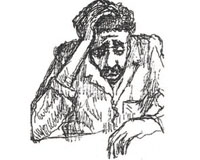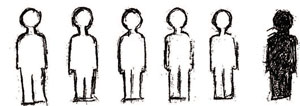Mental illness is common
Stop and think for a moment. How common do you think mental illness is in Ethiopia?
From studies that have been carried out in Ethiopia, we know that severe mental illness is present at about the same level that is found in Western countries.
Around 1 to 2% of the adult Ethiopian population, that is around 400,000 to 800,000 people across the country, are affected by psychosis. People with psychosis may believe things that aren't real, hear things that aren't there, and have disturbed behaviour. You will learn more about psychosis in Study Session 13 of this Module (see Figure 9.1).
1% means 1 person affected in every 100 persons.

A further 10 to 15% of the adult population (4 to 6 million people) suffer from depression at some point in their lifetime – approximately 5% (2 million) at any one time. In depression, people have an abnormal level of sadness that doesn't go away. Depression can lead to a person giving up on life and wanting to die. If very severe, somebody with depression may even consider killing themselves (suicide). We don't know for certain how many people commit suicide in Ethiopia every year, but it is probably at least 4,000 people (10 per 100,000 adults per year). You will learn more about depression in Study Session 12 (see Figure 9.2).

In addition, we estimate that around 5% of the adult population of Ethiopia (around 2 million people) will suffer from an anxiety illness at some point during their lifetime. Anxiety is when a person worries too much about something, for example their health, their problems, or even what will happen in the future. Study Session 16 covers anxiety disorders in more detail (see Figure 9.3).

Added to this large number is the 3 to 5% of the adult population (1.2 to 2 million people) with a serious problem resulting from their excessive use of alcohol or khat. Substance abuse will be covered in more detail in Study Session 14 (see Figure 9.4).

Children can also suffer from mental illness. In Ethiopian studies, around 1 in 10 children seem to have mental health problems (see Study Session 17).
In summary, without including childhood disorders, we estimate that at least 1 in 6 Ethiopians will suffer from a mental illness that needs treatment during their lifetime (Figure 9.5). Is this more common than you expected?

Table 9.1 summarises the frequency of the major types of mental illness in Ethiopia in terms of the percentage of the population who are affected.
Table 9.1 The frequency of mental illnesses in Ethiopia.
| Mental illness | Estimated % of Ethiopian population affected |
|---|---|
| Psychosis | 1–2% |
| Depression | 10–15% |
| Anxiety disorders | 5% |
| Alcohol and khat abuse | 3–5% |